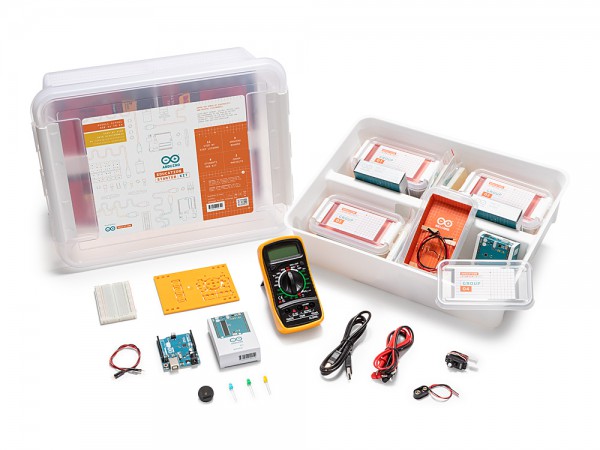- Artikel-Nr.: 193320
Learn electronics and get started with programming in your classroom
step-by-step. No experience... mehr
Produktinformationen "Arduino® Education Starter Kit"
Learn electronics and get started with programming in your classroom
step-by-step. No experience necessary.
LESSONS
Getting Started ( 30 mins).
In this lesson the students get familiar with the kit's material. Learn about electrical safety, how to setup the software and create their first program.
Lesson 1 - Electricity Fundamentals (90 mins).
In this lesson the students explore some of the basic concepts of electricity and build their first simple circuit while learning about the components that make up the circuit.
Lesson 2 - Ohm's Law ( 90 mins).
The students explore one of the physical laws that determine how electricity behaves in a circuit: Ohm's Law . They will learn, by building, the difference between parallel and series circuits and will investigate how electrical measurements behave using a multimeter as a tool.
Lesson 3 - Traffic Signals (90 mins).
In this lesson, students are introduced to the Arduino Software (IDE) and program their first light circuit that controls how the circuit operates.
Lesson 4 - Dimmer Switch (90 mins).
The students learn about the potentiometer and how they can be used manually to control a circuit. As a result, they will build an LED circuit where the Arduino board will control the brightness of the LEDs based on the position of the potentiometer. As the students code their circuit they will be introduced to concepts such as variables, conditional statements and serial communication.
Lesson 5 - Project Holiday Lights ( 90 mins).
The students will complete an open-ended project to design, build and program their own holiday light circuit. The project must follow the project's objectives, criterias and constraints.
Lesson 6 - Sports Robot ( 90 mins).
In this lesson, the students will learn how to use a servo motor to create a simple sports robot. They will program the robot to hit, kick or throw a ball.
Lesson 7 - Windshield wipers (90 mins).
This lesson introduces new programming concepts to the students such as nested conditionals, switch-case structures, and loops. The students learn the new concepts by programming and building a windshield wiper circuit.
Lesson 8 - Musical Keyboard ( 90 mins).
In this lesson, students learn about piezo buzzers and how to produce different sounds, tones and music. With that understanding, the student will build and code a musical keyboard.
Lesson 9 - Light Wave Radar (90 mins).
Students will use their Arduino board and a phototransistor to measure the intensity of the light and will learn the basic principle about how information is transmitted through light waves.
Lesson 10 - Project Greenhouse Control System (180 mins).
The students will complete an open-ended project to design, build and program a climate-control system for a greenhouse. The project must follow the project's objectives, criterias and constraints.
ABOUT
Teach middle school students the basics of programming, coding, and electronics. No prior knowledge or experience is necessary as the kits guide you through step-by-step, you are well-supported with teacher guides, and lessons can be paced according to your students' abilities. You can integrate the kit throughout the curriculum, giving your students the opportunity to become confident in programming and electronics with guided sessions and open experimentation. You'll also be teaching them vital 21st-century skills such as collaboration and problem-solving.
The Arduino Education Starter Kit contains all the hardware and software you need for eight students (in groups of 2). You get step-by-step-lessons, teacher notes, exercises, and for a complete and in-depth class experience there's also extra optional resources including activities, concepts, history, and interesting facts.
The online platform contains the teacher content, nine 90-minute lessons, and two open-ended group projects that teach students coding and electronics. Each lesson builds off the previous one, giving students a further opportunity to apply the skills and concepts they have already learned. Students also get an engineering logbook that they complete as they work through the lessons.
The beginning of each lesson provides an overview, estimated completion times, and learning objectives. Throughout each lesson, there are teacher notes and information that help the lesson go smoothly. Extension ideas are provided at the end of each lesson.
WHAT'S IN THE KIT?
The kit comes with several parts and components that students will use to build circuits as they complete lessons and projects throughout the course. Here is a brief description of what is included in the kit: Access code to exclusive online content including teachers' guidance notes, step-by-step lessons and extra materials such as resources, invention spotlights and PDF logbooks for students and teachers.
4 Arduino UNO rev 3
4 Starter Kit mounting base Easy-to-assemble plastic base
4 Battery Snap 9v
8 Batteries 9v
4 Breadboard 400 points
4 Capacitor †100uF
4 Female-male Jumper Wires (red)
4 Female-male Jumper Wires (black)
20 LEDs (red)
20 LEDs (green)
20 LEDs (yellow)
20 LEDs (blue)
4 Multimeters
4 Piezo Buzzer [PKM17EPP-4001-B0]
4 Phototransistors
8 Potentiometer 10kOhms
20 Push Button
4 Resistors - 1 kOhms
20 Resistors - 10 kOhms
20 Resistors - 220 Ohms
20 Resistors - 560 Ohms
70 Jumper Wires
4 Stranded jumper wires (red)
4 Servo Motor
4 Temperature sensor [TMP36]
4 USB Cable
12 M 3 Screw
12 M3 Bolts
step-by-step. No experience necessary.
LESSONS
Getting Started ( 30 mins).
In this lesson the students get familiar with the kit's material. Learn about electrical safety, how to setup the software and create their first program.
Lesson 1 - Electricity Fundamentals (90 mins).
In this lesson the students explore some of the basic concepts of electricity and build their first simple circuit while learning about the components that make up the circuit.
Lesson 2 - Ohm's Law ( 90 mins).
The students explore one of the physical laws that determine how electricity behaves in a circuit: Ohm's Law . They will learn, by building, the difference between parallel and series circuits and will investigate how electrical measurements behave using a multimeter as a tool.
Lesson 3 - Traffic Signals (90 mins).
In this lesson, students are introduced to the Arduino Software (IDE) and program their first light circuit that controls how the circuit operates.
Lesson 4 - Dimmer Switch (90 mins).
The students learn about the potentiometer and how they can be used manually to control a circuit. As a result, they will build an LED circuit where the Arduino board will control the brightness of the LEDs based on the position of the potentiometer. As the students code their circuit they will be introduced to concepts such as variables, conditional statements and serial communication.
Lesson 5 - Project Holiday Lights ( 90 mins).
The students will complete an open-ended project to design, build and program their own holiday light circuit. The project must follow the project's objectives, criterias and constraints.
Lesson 6 - Sports Robot ( 90 mins).
In this lesson, the students will learn how to use a servo motor to create a simple sports robot. They will program the robot to hit, kick or throw a ball.
Lesson 7 - Windshield wipers (90 mins).
This lesson introduces new programming concepts to the students such as nested conditionals, switch-case structures, and loops. The students learn the new concepts by programming and building a windshield wiper circuit.
Lesson 8 - Musical Keyboard ( 90 mins).
In this lesson, students learn about piezo buzzers and how to produce different sounds, tones and music. With that understanding, the student will build and code a musical keyboard.
Lesson 9 - Light Wave Radar (90 mins).
Students will use their Arduino board and a phototransistor to measure the intensity of the light and will learn the basic principle about how information is transmitted through light waves.
Lesson 10 - Project Greenhouse Control System (180 mins).
The students will complete an open-ended project to design, build and program a climate-control system for a greenhouse. The project must follow the project's objectives, criterias and constraints.
ABOUT
Teach middle school students the basics of programming, coding, and electronics. No prior knowledge or experience is necessary as the kits guide you through step-by-step, you are well-supported with teacher guides, and lessons can be paced according to your students' abilities. You can integrate the kit throughout the curriculum, giving your students the opportunity to become confident in programming and electronics with guided sessions and open experimentation. You'll also be teaching them vital 21st-century skills such as collaboration and problem-solving.
The Arduino Education Starter Kit contains all the hardware and software you need for eight students (in groups of 2). You get step-by-step-lessons, teacher notes, exercises, and for a complete and in-depth class experience there's also extra optional resources including activities, concepts, history, and interesting facts.
The online platform contains the teacher content, nine 90-minute lessons, and two open-ended group projects that teach students coding and electronics. Each lesson builds off the previous one, giving students a further opportunity to apply the skills and concepts they have already learned. Students also get an engineering logbook that they complete as they work through the lessons.
The beginning of each lesson provides an overview, estimated completion times, and learning objectives. Throughout each lesson, there are teacher notes and information that help the lesson go smoothly. Extension ideas are provided at the end of each lesson.
WHAT'S IN THE KIT?
The kit comes with several parts and components that students will use to build circuits as they complete lessons and projects throughout the course. Here is a brief description of what is included in the kit: Access code to exclusive online content including teachers' guidance notes, step-by-step lessons and extra materials such as resources, invention spotlights and PDF logbooks for students and teachers.
4 Arduino UNO rev 3
4 Starter Kit mounting base Easy-to-assemble plastic base
4 Battery Snap 9v
8 Batteries 9v
4 Breadboard 400 points
4 Capacitor †100uF
4 Female-male Jumper Wires (red)
4 Female-male Jumper Wires (black)
20 LEDs (red)
20 LEDs (green)
20 LEDs (yellow)
20 LEDs (blue)
4 Multimeters
4 Piezo Buzzer [PKM17EPP-4001-B0]
4 Phototransistors
8 Potentiometer 10kOhms
20 Push Button
4 Resistors - 1 kOhms
20 Resistors - 10 kOhms
20 Resistors - 220 Ohms
20 Resistors - 560 Ohms
70 Jumper Wires
4 Stranded jumper wires (red)
4 Servo Motor
4 Temperature sensor [TMP36]
4 USB Cable
12 M 3 Screw
12 M3 Bolts
Weiterführende Links zu "Arduino® Education Starter Kit"
Bewertungen lesen, schreiben und diskutieren... mehr
Kundenbewertungen für "Arduino® Education Starter Kit"
Bewertung schreiben
Bewertungen werden nach Überprüfung freigeschaltet.
Zuletzt angesehen





















